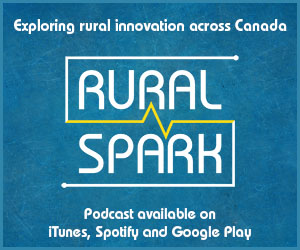BEAVER HARBOUR — Many people hang feeders on their properties to provide nourishment for their feathered friends, a highly regarded practice that may seem mundane compared to an effort put forth by a couple from this Eastern Shore community to provide a home-away-from-home for Nova Scotia’s provincial bird.
Late last month, with plenty of help from friends and neighbours, Grayley McWatters and Maria Revelis returned a tree to its verticality that had been felled almost 18 months ago by the wrath of post-tropical storm Fiona.
And, most importantly, it restored an osprey nest to its perch, one that people in the area estimated had welcomed pairs of the migratory bird to bear their chicks for approximately half a century.
When the couple purchased the property – acreage earmarked by the Ontarians for their East Coast retirement home – they were looking forward to watching and learning about the rare bird in its natural habitat.
Despite losing the tree that housed the osprey nest – one of 80 trees wiped out by the Fiona-related encounter with Mother Nature, McWatters and Revelis were undeterred. They decided to do whatever they could to provide an option for some of those birds when they made their yearly stop in the region.
“It was a unique feature of our property,” McWatters told The Journal of the well-known nest.
He explained that the tree “sort of landed where it stood,” while the pieces of the nest were “sprinkled around it.”
As he researched ways in which “to try to attract birds,” McWatters discovered the need to construct a platform, along with options and instructions on how to construct one.
“And, of course, try to make sure that it stays in place,” he added, with a laugh.
Along with the research and planning process of recent months, McWatters launched a recruiting drive, of sorts. He often made his pitch while enjoying a pint with friends and neighbours at the local pub.
“They were happy to do it,” he said of those who volunteered to pitch in.
Back in the sky
So, on March 23, Tara Rutherford, Will Wientjes, Rob Winter, Gerry Hawes, Clifford Hawes and Angie Cumming joined the couple to carry out the effort, which took more than four hours, to erect the tree with its new platform and revamped nest.
“Of course, we couldn’t have done it without them,” McWatters said.
They melded that person power and elbow grease with crucial equipment, such as an excavator from Hawes Contracting; not to mention “a little bit of creativity.”
“Much like the Egyptians,” McWatters described of the effort put forth by the excavator operator and people holding the ropes to secure the tree and “all the trimmings.”
Once in place, stones filled in the hole around the tree’s base dug by the excavator.
“There’s no shortage of rock,” he said of its availability on their property.
And, McWatters added, with a hearty laugh, “It is fairly vertical.”
If the tree needs to be stabilized further, he noted that some concrete may be added to the base.
As for the timing for tackling the task, he explained that it had to be done before nesting pairs started to arrive in the province.
“It would be all for naught [this year],” McWatters said, if they missed that window of opportunity.
Assuming that the osprey pair that inhabited the nest in 2022 – there was none last year – have “moved on,” he quipped that they are hoping to “recruit new tenants.”
“Now, we are just waiting for Mother Nature,” he added, when it comes potential arrival of newcomers.
He added, “We know there are no assurances.”
Describing it as a “wonderful thing,” McWatters remembered how – before the tree fell and the nest was destroyed – they enjoyed watching the osprey take flight and then return with fish to feed for their young.
He added, “It was a tremendous bonus – great times,” of those moments shared on their 55 acres.
Although they are living approximately a half-hour away from their Beaver Harbour property – at an Airbnb in Spry Bay, where they been over the winter months – neigbours are keeping an eye out for any activity. The couple also has a camera mounted on their RV parked on the land. Technology, particularly an app on their cellphones, allows them to monitor the situation 24 hours a day.
“We hope and pray – we are staying optimistic,” McWatters said of their wait for the arrival of any winged visitors.
He quipped, “But, we haven’t had any customers yet.”
Creatures of habit
Shavonne Meyer – a regional biologist with the Nova Scotia Department of Natural Resources and Renewables (DNRR) – told The Journal that osprey select nesting sites close to water that boast terrific sightlines, which are often located above the forest canopy and in the open.
She explained that the birds often select human-made structures – such as power poles – for their nests, which leave them vulnerable to hazards, such as fires and collisions with electrical lines. Or, if their site selection adversely affects the functionality of where they built their seasonal home, they have to be relocated.
But, as Meyer explained, the osprey have a few things in their favour to prevent these issues, including the seasonality of their nesting. For instance, when Fiona blew through the province, the nests – like the one on the couple’s property in Beaver Harbour that was dislodged – were vacant.
She pointed out that, when it comes to relocating osprey nests, the department does “a lot of work” with industrial partners, such as Nova Scotia Power.
“Basically, something happens. It could be a nest fire; maybe they need to do maintenance, maybe they need to paint poles on a power line. …” she offered as an example.
When it comes to residents tackling such a task, Meyer added, “That’s not as common, that’s going the extra mile, for sure.”
As for the ospreys return last year, McWatters said, “They were spotted in flight, but eventually moved on,”
As for the probability they will return to the Beaver Harbour location, Meyer offered that the one-year absence – with no nesting there in 2023 – would lessen the chances.
“If the pair did find an alternative site, where they found success, it would be a little more questionable,” she said.
Nevertheless, considering that the birds have “such a strong sense of nesting site fidelity,” she wouldn’t rule out the possibility.
Bearing in mind the location’s history for attracting osprey, Meyer said the chance that birds will return and nest is “pretty good.”
Noting that it may take a couple of years, she pointed out that – as they mature – osprey hatched in that spot could have a homecoming.
Osprey start to arrive in Nova Scotia in April – hence, the urgency for McWatters in getting the nest in place – after spending the winter in South America and the Caribbean. While here, they lay up to four eggs, usually three, by May. By mid-June, most eggs have hatched. It takes seven to eight weeks for a chick to learn to fly. Although most have fledged by early September it is not uncommon for osprey to perch, eat and rest well into the fall.
Adults fly south first, usually in September, while their young follow a little later. The latter return here after a couple of years in the south, where they mature and develop their fishing skills.
Another key adaptive trait of the osprey is their ability to effectively and efficiently build, re-build and tend to their nests, so they are capable of quickly restoring their northern homes when they are blown down or damaged.
But, of course, that can’t happen if the base for the nest – like a tree – ends up on the ground.
The numbers
Noting that some organizations attempt to tally how many osprey visit the province, Meyer offered, it is “kind of difficult.”
“We take reports from the public … but we don’t have active population monitoring going on, per se,” she said.
Meyer noted of osprey numbers, “Generally, [it] would just be considered to be very healthy.”
She added, “We are just lucky in Nova Scotia that we have a lot of habitat, a lot of good places for osprey to be.”
Meyer said that her department encourages residents who may be aware of an osprey nest on their property – or in the community – to report it to BIODIVERSITY@novascotia.ca or to their local DNRR office. With biologists available to provide advice, she also recommended that people contact them regarding conservation efforts. And, since prohibitions under the Wildlife Act may apply, to ensure any efforts are compatible with that legislation.
‘Everyone jumped in’
The Beaver Harbour couple plans to start building their house in June. By then, they hope that some feathered friends will already be settled in.
“She fell in love with the place,” McWatters explained of his partner’s visit to the province that led to their relocation.
He noted their piece of heaven along Marine Drive also fulfills her desire to live by the water.
One of the early lessons that the newbie East Coasters have learned, particularly during this quest to restore an osprey nest, is “everybody pitches in.”
McWatters added, “It has certainly helped deepen the bond that we had started with our neighbours.
“We are very appreciative – they jumped in.”
As of press time, there were no osprey sightings.








